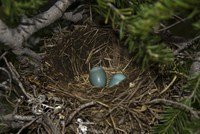April 25, 2013
Egg Laying
Idaho Falls Post Register
The sage-grouse males are still strutting their stuff and may continue for several more weeks, but the number of females enjoying the show has definitely tapered off. Most have already selected a mate and are now actively building nests and laying eggs.
Birds lay eggs to reproduce. However, birds aren’t the only critters in the animal kingdom to lay eggs in one form or another. In fact, among the higher forms of life, only mammals have true live birth where the embryo is nourished by the mother until delivery (a few species, such as some sharks, come close). Even then, mammals start from a fertilized egg and there are five mammal species comprising the primitive Order Monotremata (think duckbilled platypus) that actually do lay eggs. Besides birds and monotremes, fish, crustaceans, insects, spiders, octopi, reptiles, and amphibians all lay eggs.
Fertilization of the egg is the first step in creating the next generation. In species that live out of the water, internal fertilization occurs when two individuals mate. However, in the water fertilization is often external. The female lays the eggs and then the male covers them with his sperm. As an example, think of a salmon spawning.
Laying eggs (called oviparity) creates a problem for animal moms of all types. Eggs are vulnerable to predation and destruction while the embryo develops and each species must devise a way to ensure that some offspring can survive.
One of the top strategies is just to lay thousands or even millions of eggs in a good environment and walk or swim away. This tactic relies on sheer volume of eggs to overwhelm predators and ensure that at least a few of the young reach maturity. This is a strategy employed by many fish, crustaceans such as horseshoe crabs, and insects.
Another stratagem, one practiced by a surprising number of species, is to lay a smaller cluster of eggs, but then guard those eggs. Alligators, African bullfrogs, praying mantises, clown fish, and salamanders are all examples of caring parents that keep a watchful eye on their eggs.
However, the octopus may be the best example of parental devotion. The female deposits her fertilized eggs in a secure location and guards them until she perishes from starvation.
Still other species, including more than 200 species of sharks, avoid the whole egg laying process altogether. They protect the eggs by retaining them in their bodies and give birth to live young (called viviparity). However, this isn’t the same as mammalian birth. The eggs are supported by their own yolks not a placenta. The mother’s uterus just acts as a safe haven.
Caring for the eggs is usually a maternal role, but in some species the male is the protector. In what is sometimes termed male pregnancy, sea horse males accept the eggs from their partner into a special pouch on their abdomen. They fertilize the eggs in the pouch and care for them until they hatch and swim away.
Birds provide some great and easy to see examples of egg laying behavior. However, they certainly don’t have a corner on the egg market.
By Terry Thomas
Terry Thomas is a wildlife biologist with 26 years experience. Opinions expressed are his own

Laying eggs is a necessary, but dangerous game played by most animals on Earth. They have developed many strategies to ensure that eggs survive.